Living labs - một cách tiếp cận phục vụ nghiên cứu và triển khai các dự án quản lý sông, kênh rạch trên địa bàn TP.HCM
Ho Chi Minh city has a beautiful water landscape with populated rivers and
canals networks. Over the last few decades, however, the water system has been
compromisedas a result of water pollution, informal settlements, and unregulated
development. Consequently, the city has been working in order to improve the current
situation through various urban upgrading projects. While some promising international
projects through the World Bank, Japan and Belgiumhave undertaken efforts to
rehabilitate the river networks in HCMC, the city is still faced with multiple issues to
develop and implement multi-purpose and multi-functional river restoration projects.
Typical reasons for failurehave been attributed to limited time preparation, lack of
holistic perspectives, lack of stakeholder involvement, and limited implementation
capacity. In this paper, we introduce the concept of “Living Labs,” which includes five
main components: (1) Multi-Method Approach; (2) User Engagement; (3) MultiStakeholder Participation; (4) Real-life Setting; (5) Innovation and co-Creation.Living
Labs offer to support the development and implementation of river management
projects in Ho Chi Minh city. We use the case of Xuyen Tam canal as an illustration of
how the concept can be implemented in practice
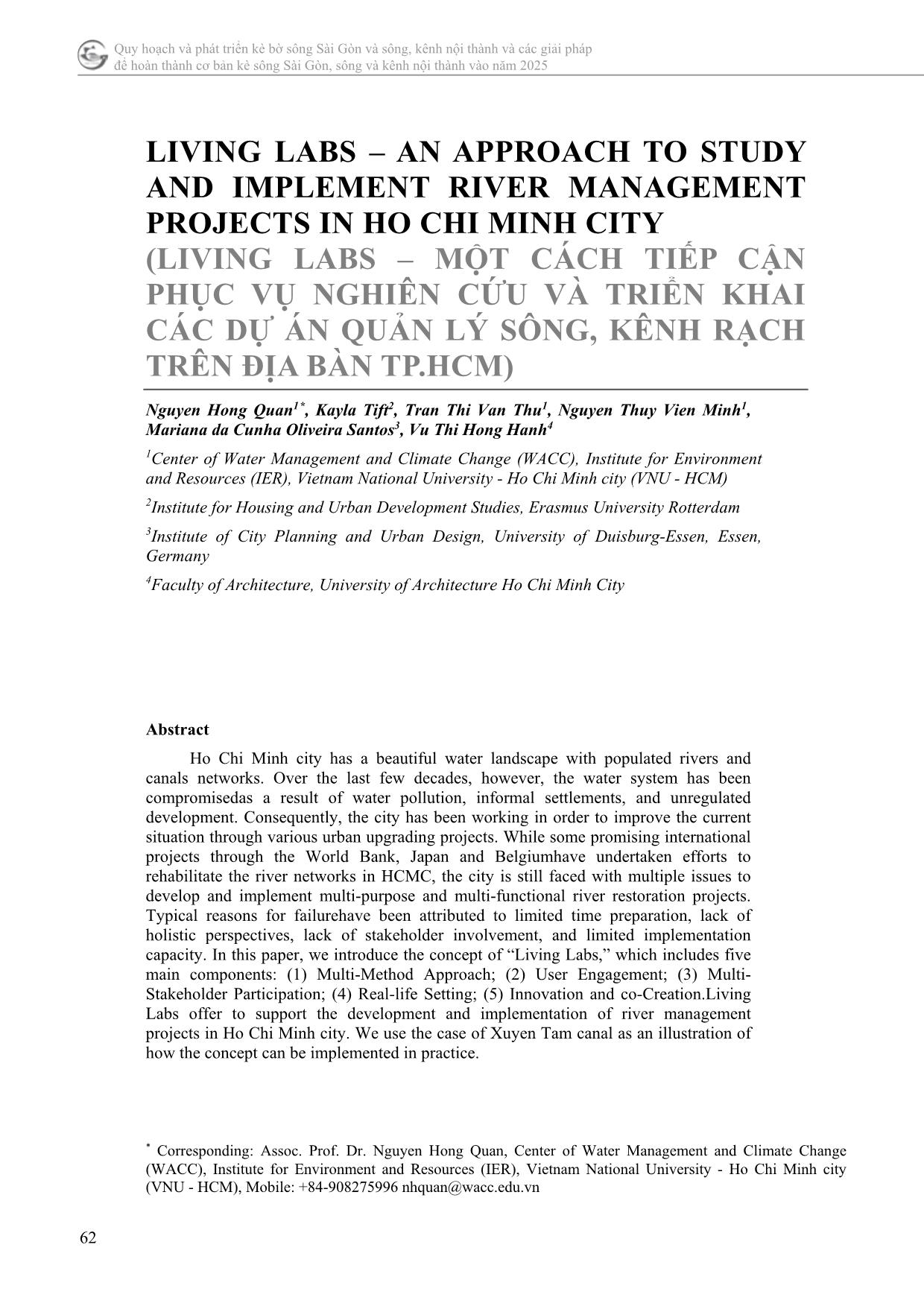
Trang 1
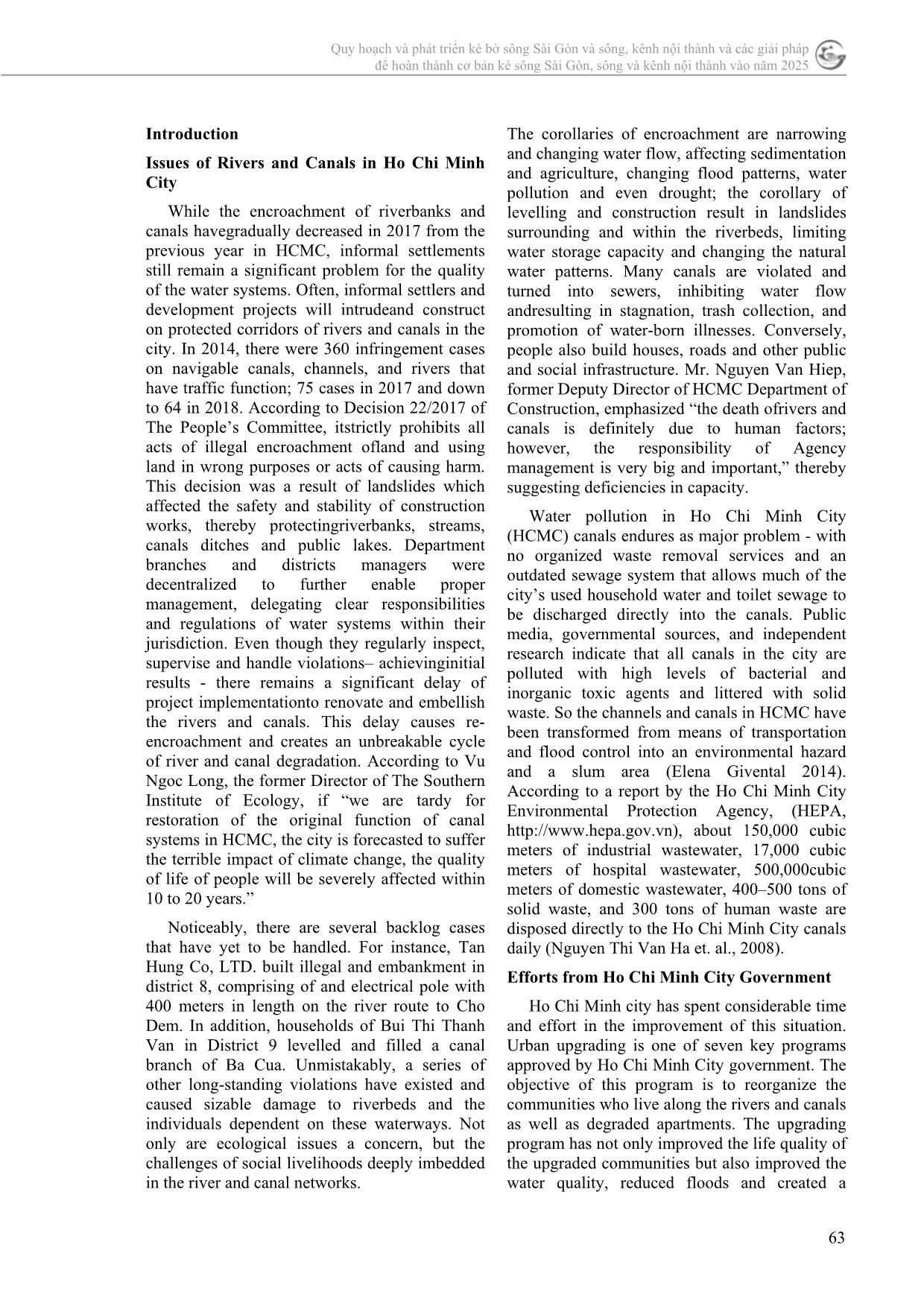
Trang 2
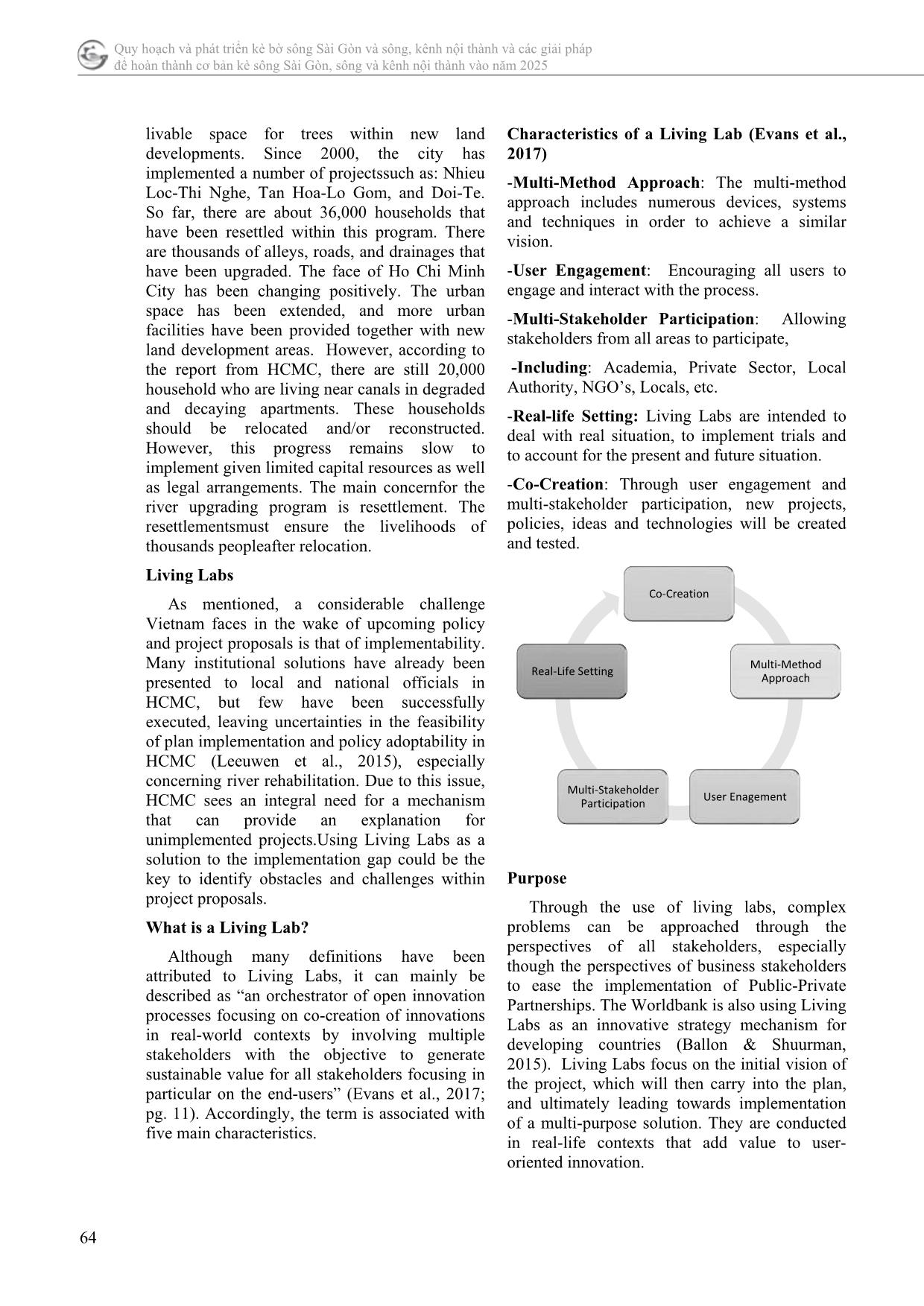
Trang 3
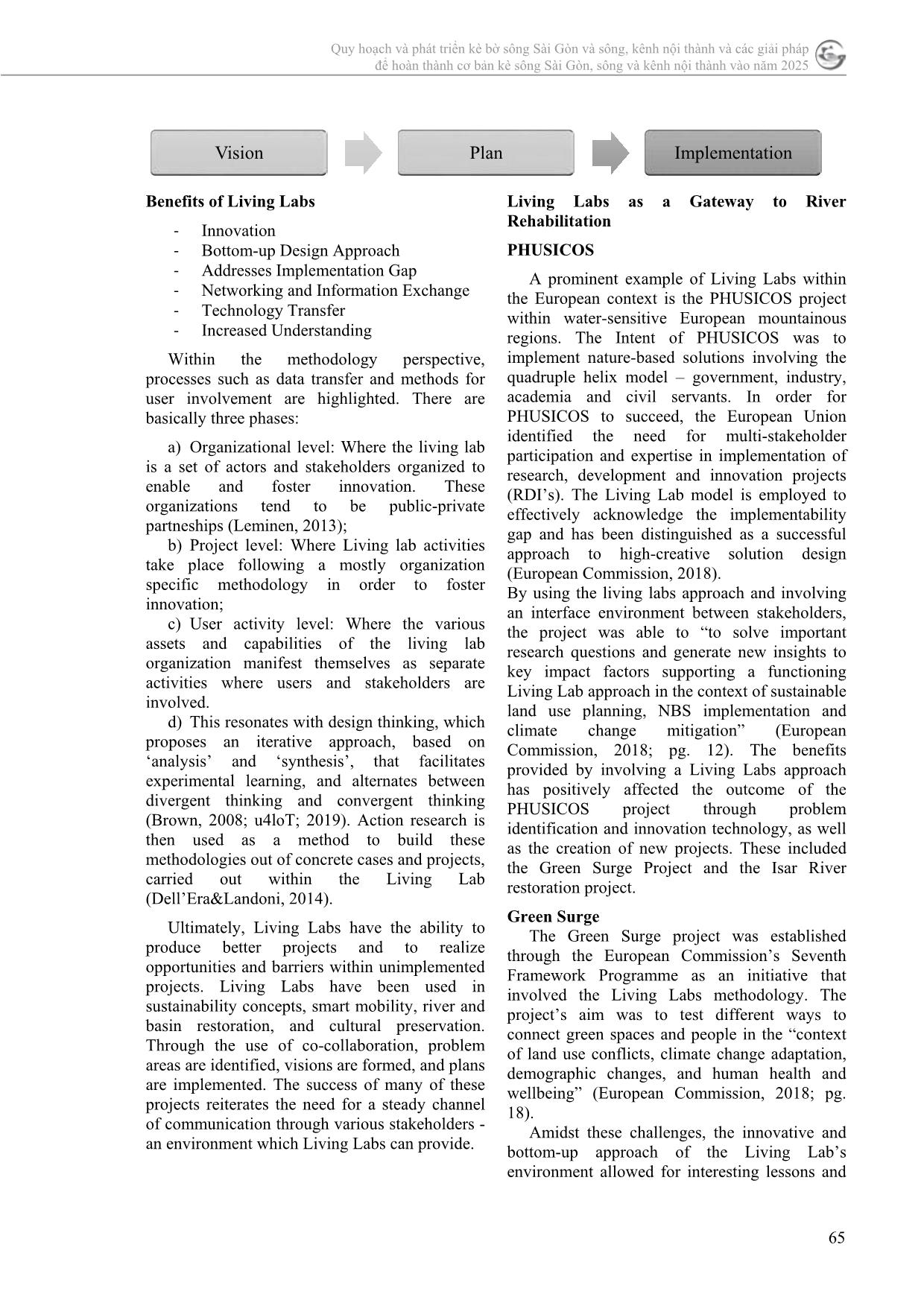
Trang 4
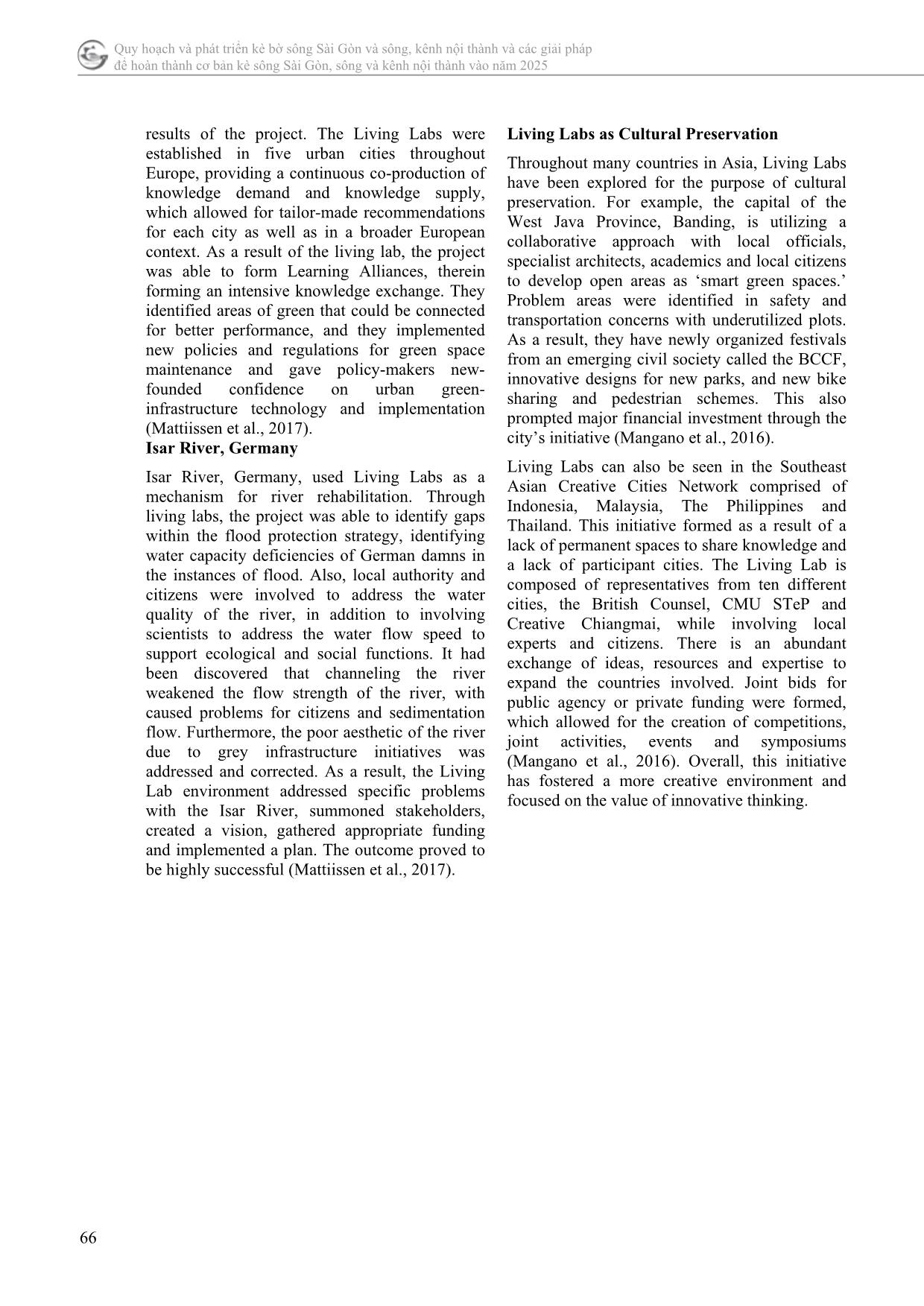
Trang 5
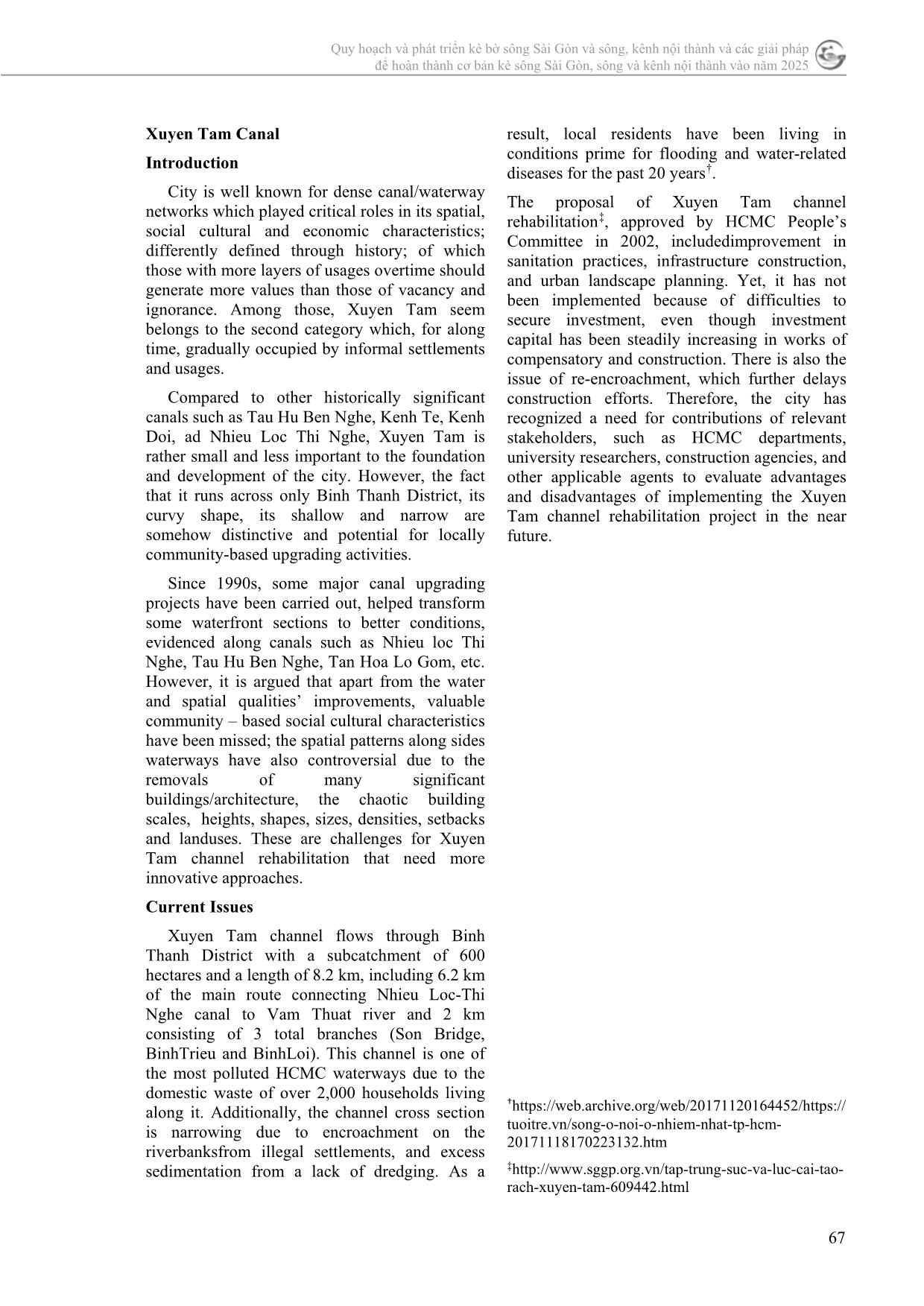
Trang 6
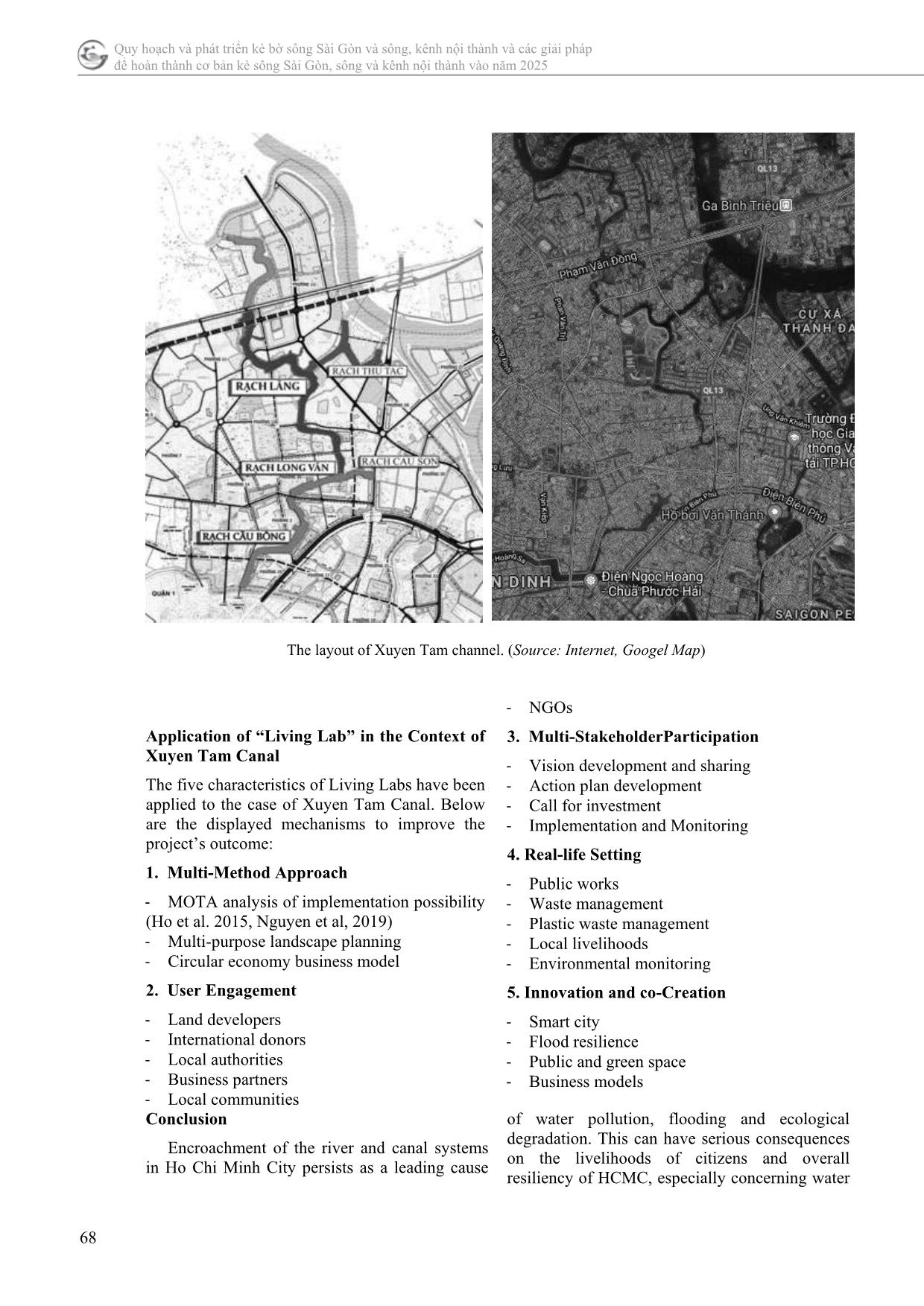
Trang 7
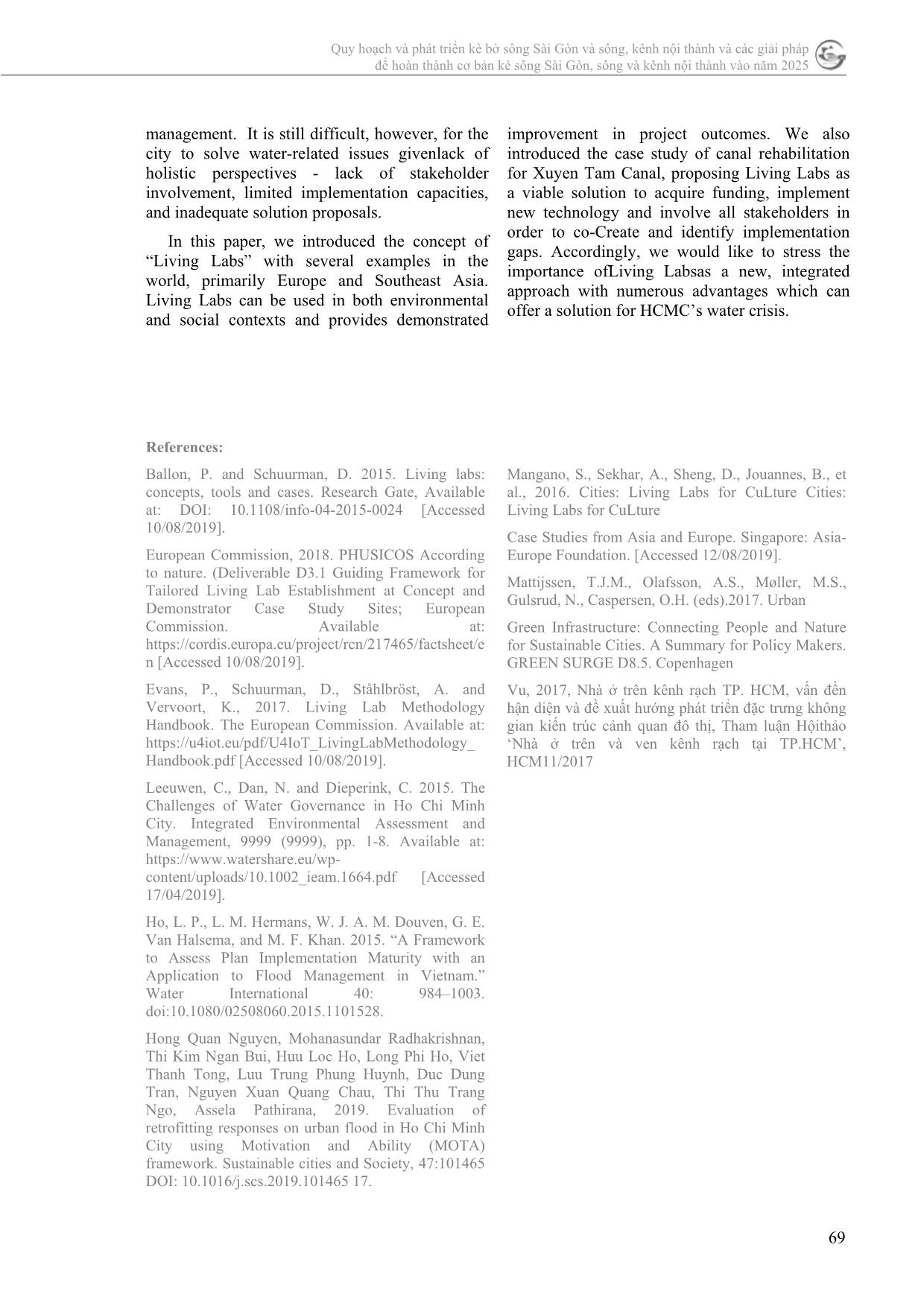
Trang 8
Tóm tắt nội dung tài liệu: Living labs - một cách tiếp cận phục vụ nghiên cứu và triển khai các dự án quản lý sông, kênh rạch trên địa bàn TP.HCM

Quy hoạch và phát triển kè bờ sông Sài Gòn và sông, kênh nội thành và các giải pháp để hoàn thành cơ bản kè sông Sài Gòn, sông và kênh nội thành vào năm 2025 LIVING LABS – AN APPROACH TO STUDY AND IMPLEMENT RIVER MANAGEMENT PROJECTS IN HO CHI MINH CITY (LIVING LABS – MỘT CÁCH TIẾP CẬN PHỤC VỤ NGHIÊN CỨU VÀ TRIỂN KHAI CÁC DỰ ÁN QUẢN LÝ SÔNG, KÊNH RẠCH TRÊN ĐỊA BÀN TP.HCM) Nguyen Hong Quan1*, Kayla Tift2, Tran Thi Van Thu1, Nguyen Thuy Vien Minh1, Mariana da Cunha Oliveira Santos3, Vu Thi Hong Hanh4 1Center of Water Management and Climate Change (WACC), Institute for Environment and Resources (IER), Vietnam National University - Ho Chi Minh city (VNU - HCM) 2Institute for Housing and Urban Development Studies, Erasmus University Rotterdam 3Institute of City Planning and Urban Design, University of Duisburg-Essen, Essen, Germany 4Faculty of Architecture, University of Architecture Ho Chi Minh City Abstract Ho Chi Minh city has a beautiful water landscape with populated rivers and canals networks. Over the last few decades, however, the water system has been compromisedas a result of water pollution, informal settlements, and unregulated development. Consequently, the city has been working in order to improve the current situation through various urban upgrading projects. While some promising international projects through the World Bank, Japan and Belgiumhave undertaken efforts to rehabilitate the river networks in HCMC, the city is still faced with multiple issues to develop and implement multi-purpose and multi-functional river restoration projects. Typical reasons for failurehave been attributed to limited time preparation, lack of holistic perspectives, lack of stakeholder involvement, and limited implementation capacity. In this paper, we introduce the concept of “Living Labs,” which includes five main components: (1) Multi-Method Approach; (2) User Engagement; (3) Multi- Stakeholder Participation; (4) Real-life Setting; (5) Innovation and co-Creation.Living Labs offer to support the development and implementation of river management projects in Ho Chi Minh city. We use the case of Xuyen Tam canal as an illustration of how the concept can be implemented in practice. * Corresponding: Assoc. Prof. Dr. Nguyen Hong Quan, Center of Water Management and Climate Change (WACC), Institute for Environment and Resources (IER), Vietnam National University - Ho Chi Minh city (VNU - HCM), Mobile: +84-908275996 nhquan@wacc.edu.vn 62 Quy hoạch và phát triển kè bờ sông Sài Gòn và sông, kênh nội thành và các giải pháp để hoàn thành cơ bản kè sông Sài Gòn, sông và kênh nội thành vào năm 2025 Introduction Issues of Rivers and Canals in Ho Chi Minh City While the encroachment of riverbanks and canals havegradually decreased in 2017 from the previous year in HCMC, informal settlements still remain a significant problem for the quality of the water systems. Often, informal settlers and development projects will intrudeand construct on protected corridors of rivers and canals in the city. In 2014, there were 360 infringement cases on navigable canals, channels, and rivers that have traffic function; 75 cases in 2017 and down to 64 in 2018. According to Decision 22/2017 of The People’s Committee, itstrictly prohibits all acts of illegal encroachment ofland and using land in wrong purposes or acts of causing harm. This decision was a result of landslides which affected the safety and stability of construction works, thereby protectingriverbanks, streams, canals ditches and public lakes. Department branches and districts managers were decentralized to further enable proper management, delegating clear responsibilities and regulations of water systems within their jurisdiction. Even though they regularly inspect, supervise and handle violations– achievinginitial results - there remains a significant delay of project implementationto renovate and embellish the rivers and canals. This delay causes re- encroachment and creates an unbreakable cycle of river and canal degradation. According to Vu Ngoc Long, the former Director of The Southern Institute of Ecology, if “we are tardy for restoration of the original function of canal systems in HCMC, the city is forecasted to suffer the terrible impact of climate change, the quality of life of people will be severely affected within 10 to 20 years.” Noticeably, there are several backlog cases that have yet to be handled. For instance, Tan Hung Co, LTD. built illegal and embankment in district 8, comprising of and electrical pole with 400 meters in length on the river route to Cho Dem. In addition, households of Bui Thi Thanh Van in District 9 levelled and filled a canal branch of Ba Cua. Unmistakably, a series of other long-standing violations have existed and caused sizable damage to riverbeds and the individuals dependent on these waterways. Not only are ecological issues a concern, but the challenges of social livelihoods deeply imbedded in the river and canal networks. The corollaries of encroachment are narrowing and changing water flow, affecting sedimentation and agriculture, changing flood patterns, water pollution and even drought; the corollary of levelling and construction result in landslides surrounding and within the riverbeds, limiting water storage capacity and changing the natural water patterns. Many canals are violated and turned into sewers, inhibiting water flow andresulting in stagnation, trash collection, and promotion of water-born illnesses. Conversely, people also build houses, roads and other public and social infrastructure. Mr. Nguyen Van Hiep, former Deputy Director of HCMC Department of Construction, emphasized “the death ofrivers and canals is definitely due to human factors; however, the responsibility of Agency management is very ... opean mountainous regions. The Intent of PHUSICOS was to implement nature-based solutions involving the quadruple helix model – government, industry, academia and civil servants. In order for PHUSICOS to succeed, the European Union identified the need for multi-stakeholder participation and expertise in implementation of research, development and innovation projects (RDI’s). The Living Lab model is employed to effectively acknowledge the implementability gap and has been distinguished as a successful approach to high-creative solution design (European Commission, 2018). By using the living labs approach and involving an interface environment between stakeholders, the project was able to “to solve important research questions and generate new insights to key impact factors supporting a functioning Living Lab approach in the context of sustainable land use planning, NBS implementation and climate change mitigation” (European Commission, 2018; pg. 12). The benefits provided by involving a Living Labs approach has positively affected the outcome of the PHUSICOS project through problem identification and innovation technology, as well as the creation of new projects. These included the Green Surge Project and the Isar River restoration project. Green Surge The Green Surge project was established through the European Commission’s Seventh Framework Programme as an initiative that involved the Living Labs methodology. The project’s aim was to test different ways to connect green spaces and people in the “context of land use conflicts, climate change adaptation, demographic changes, and human health and wellbeing” (European Commission, 2018; pg. 18). Amidst these challenges, the innovative and bottom-up approach of the Living Lab’s environment allowed for interesting lessons and Vision Plan Implementation 65 Quy hoạch và phát triển kè bờ sông Sài Gòn và sông, kênh nội thành và các giải pháp để hoàn thành cơ bản kè sông Sài Gòn, sông và kênh nội thành vào năm 2025 results of the project. The Living Labs were established in five urban cities throughout Europe, providing a continuous co-production of knowledge demand and knowledge supply, which allowed for tailor-made recommendations for each city as well as in a broader European context. As a result of the living lab, the project was able to form Learning Alliances, therein forming an intensive knowledge exchange. They identified areas of green that could be connected for better performance, and they implemented new policies and regulations for green space maintenance and gave policy-makers new- founded confidence on urban green- infrastructure technology and implementation (Mattiissen et al., 2017). Isar River, Germany Isar River, Germany, used Living Labs as a mechanism for river rehabilitation. Through living labs, the project was able to identify gaps within the flood protection strategy, identifying water capacity deficiencies of German damns in the instances of flood. Also, local authority and citizens were involved to address the water quality of the river, in addition to involving scientists to address the water flow speed to support ecological and social functions. It had been discovered that channeling the river weakened the flow strength of the river, with caused problems for citizens and sedimentation flow. Furthermore, the poor aesthetic of the river due to grey infrastructure initiatives was addressed and corrected. As a result, the Living Lab environment addressed specific problems with the Isar River, summoned stakeholders, created a vision, gathered appropriate funding and implemented a plan. The outcome proved to be highly successful (Mattiissen et al., 2017). Living Labs as Cultural Preservation Throughout many countries in Asia, Living Labs have been explored for the purpose of cultural preservation. For example, the capital of the West Java Province, Banding, is utilizing a collaborative approach with local officials, specialist architects, academics and local citizens to develop open areas as ‘smart green spaces.’ Problem areas were identified in safety and transportation concerns with underutilized plots. As a result, they have newly organized festivals from an emerging civil society called the BCCF, innovative designs for new parks, and new bike sharing and pedestrian schemes. This also prompted major financial investment through the city’s initiative (Mangano et al., 2016). Living Labs can also be seen in the Southeast Asian Creative Cities Network comprised of Indonesia, Malaysia, The Philippines and Thailand. This initiative formed as a result of a lack of permanent spaces to share knowledge and a lack of participant cities. The Living Lab is composed of representatives from ten different cities, the British Counsel, CMU STeP and Creative Chiangmai, while involving local experts and citizens. There is an abundant exchange of ideas, resources and expertise to expand the countries involved. Joint bids for public agency or private funding were formed, which allowed for the creation of competitions, joint activities, events and symposiums (Mangano et al., 2016). Overall, this initiative has fostered a more creative environment and focused on the value of innovative thinking. 66 Quy hoạch và phát triển kè bờ sông Sài Gòn và sông, kênh nội thành và các giải pháp để hoàn thành cơ bản kè sông Sài Gòn, sông và kênh nội thành vào năm 2025 Xuyen Tam Canal Introduction City is well known for dense canal/waterway networks which played critical roles in its spatial, social cultural and economic characteristics; differently defined through history; of which those with more layers of usages overtime should generate more values than those of vacancy and ignorance. Among those, Xuyen Tam seem belongs to the second category which, for along time, gradually occupied by informal settlements and usages. Compared to other historically significant canals such as Tau Hu Ben Nghe, Kenh Te, Kenh Doi, ad Nhieu Loc Thi Nghe, Xuyen Tam is rather small and less important to the foundation and development of the city. However, the fact that it runs across only Binh Thanh District, its curvy shape, its shallow and narrow are somehow distinctive and potential for locally community-based upgrading activities. Since 1990s, some major canal upgrading projects have been carried out, helped transform some waterfront sections to better conditions, evidenced along canals such as Nhieu loc Thi Nghe, Tau Hu Ben Nghe, Tan Hoa Lo Gom, etc. However, it is argued that apart from the water and spatial qualities’ improvements, valuable community – based social cultural characteristics have been missed; the spatial patterns along sides waterways have also controversial due to the removals of many significant buildings/architecture, the chaotic building scales, heights, shapes, sizes, densities, setbacks and landuses. These are challenges for Xuyen Tam channel rehabilitation that need more innovative approaches. Current Issues Xuyen Tam channel flows through Binh Thanh District with a subcatchment of 600 hectares and a length of 8.2 km, including 6.2 km of the main route connecting Nhieu Loc-Thi Nghe canal to Vam Thuat river and 2 km consisting of 3 total branches (Son Bridge, BinhTrieu and BinhLoi). This channel is one of the most polluted HCMC waterways due to the domestic waste of over 2,000 households living along it. Additionally, the channel cross section is narrowing due to encroachment on the riverbanksfrom illegal settlements, and excess sedimentation from a lack of dredging. As a result, local residents have been living in conditions prime for flooding and water-related diseases for the past 20 years†. The proposal of Xuyen Tam channel rehabilitation‡, approved by HCMC People’s Committee in 2002, includedimprovement in sanitation practices, infrastructure construction, and urban landscape planning. Yet, it has not been implemented because of difficulties to secure investment, even though investment capital has been steadily increasing in works of compensatory and construction. There is also the issue of re-encroachment, which further delays construction efforts. Therefore, the city has recognized a need for contributions of relevant stakeholders, such as HCMC departments, university researchers, construction agencies, and other applicable agents to evaluate advantages and disadvantages of implementing the Xuyen Tam channel rehabilitation project in the near future. †https://web.archive.org/web/20171120164452/https:// tuoitre.vn/song-o-noi-o-nhiem-nhat-tp-hcm- 20171118170223132.htm ‡ rach-xuyen-tam-609442.html 67 Quy hoạch và phát triển kè bờ sông Sài Gòn và sông, kênh nội thành và các giải pháp để hoàn thành cơ bản kè sông Sài Gòn, sông và kênh nội thành vào năm 2025 The layout of Xuyen Tam channel. (Source: Internet, Googel Map) Application of “Living Lab” in the Context of Xuyen Tam Canal The five characteristics of Living Labs have been applied to the case of Xuyen Tam Canal. Below are the displayed mechanisms to improve the project’s outcome: 1. Multi-Method Approach - MOTA analysis of implementation possibility (Ho et al. 2015, Nguyen et al, 2019) - Multi-purpose landscape planning - Circular economy business model 2. User Engagement - Land developers - International donors - Local authorities - Business partners - Local communities - NGOs 3. Multi-StakeholderParticipation - Vision development and sharing - Action plan development - Call for investment - Implementation and Monitoring 4. Real-life Setting - Public works - Waste management - Plastic waste management - Local livelihoods - Environmental monitoring 5. Innovation and co-Creation - Smart city - Flood resilience - Public and green space - Business models Conclusion Encroachment of the river and canal systems in Ho Chi Minh City persists as a leading cause of water pollution, flooding and ecological degradation. This can have serious consequences on the livelihoods of citizens and overall resiliency of HCMC, especially concerning water 68 Quy hoạch và phát triển kè bờ sông Sài Gòn và sông, kênh nội thành và các giải pháp để hoàn thành cơ bản kè sông Sài Gòn, sông và kênh nội thành vào năm 2025 management. It is still difficult, however, for the city to solve water-related issues givenlack of holistic perspectives - lack of stakeholder involvement, limited implementation capacities, and inadequate solution proposals. In this paper, we introduced the concept of “Living Labs” with several examples in the world, primarily Europe and Southeast Asia. Living Labs can be used in both environmental and social contexts and provides demonstrated improvement in project outcomes. We also introduced the case study of canal rehabilitation for Xuyen Tam Canal, proposing Living Labs as a viable solution to acquire funding, implement new technology and involve all stakeholders in order to co-Create and identify implementation gaps. Accordingly, we would like to stress the importance ofLiving Labsas a new, integrated approach with numerous advantages which can offer a solution for HCMC’s water crisis. References: Ballon, P. and Schuurman, D. 2015. Living labs: concepts, tools and cases. Research Gate, Available at: DOI: 10.1108/info-04-2015-0024 [Accessed 10/08/2019]. European Commission, 2018. PHUSICOS According to nature. (Deliverable D3.1 Guiding Framework for Tailored Living Lab Establishment at Concept and Demonstrator Case Study Sites; European Commission. Available at: https://cordis.europa.eu/project/rcn/217465/factsheet/e n [Accessed 10/08/2019]. Evans, P., Schuurman, D., Ståhlbröst, A. and Vervoort, K., 2017. Living Lab Methodology Handbook. The European Commission. Available at: https://u4iot.eu/pdf/U4IoT_LivingLabMethodology_ Handbook.pdf [Accessed 10/08/2019]. Leeuwen, C., Dan, N. and Dieperink, C. 2015. The Challenges of Water Governance in Ho Chi Minh City. Integrated Environmental Assessment and Management, 9999 (9999), pp. 1-8. Available at: https://www.watershare.eu/wp- content/uploads/10.1002_ieam.1664.pdf [Accessed 17/04/2019]. Ho, L. P., L. M. Hermans, W. J. A. M. Douven, G. E. Van Halsema, and M. F. Khan. 2015. “A Framework to Assess Plan Implementation Maturity with an Application to Flood Management in Vietnam.” Water International 40: 984–1003. doi:10.1080/02508060.2015.1101528. Hong Quan Nguyen, Mohanasundar Radhakrishnan, Thi Kim Ngan Bui, Huu Loc Ho, Long Phi Ho, Viet Thanh Tong, Luu Trung Phung Huynh, Duc Dung Tran, Nguyen Xuan Quang Chau, Thi Thu Trang Ngo, Assela Pathirana, 2019. Evaluation of retrofitting responses on urban flood in Ho Chi Minh City using Motivation and Ability (MOTA) framework. Sustainable cities and Society, 47:101465 DOI: 10.1016/j.scs.2019.101465 17. Mangano, S., Sekhar, A., Sheng, D., Jouannes, B., et al., 2016. Cities: Living Labs for CuLture Cities: Living Labs for CuLture Case Studies from Asia and Europe. Singapore: Asia- Europe Foundation. [Accessed 12/08/2019]. Mattijssen, T.J.M., Olafsson, A.S., Møller, M.S., Gulsrud, N., Caspersen, O.H. (eds).2017. Urban Green Infrastructure: Connecting People and Nature for Sustainable Cities. A Summary for Policy Makers. GREEN SURGE D8.5. Copenhagen Vu, 2017, Nhà ở trên kênh rạch TP. HCM, vấn đền hận diện và đề xuất hướng phát triển đặc trưng không gian kiến trúc cảnh quan đô thị, Tham luận Hộithảo ‘Nhà ở trên và ven kênh rạch tại TP.HCM’, HCM11/2017 69
File đính kèm:
 living_labs_mot_cach_tiep_can_phuc_vu_nghien_cuu_va_trien_kh.pdf
living_labs_mot_cach_tiep_can_phuc_vu_nghien_cuu_va_trien_kh.pdf

